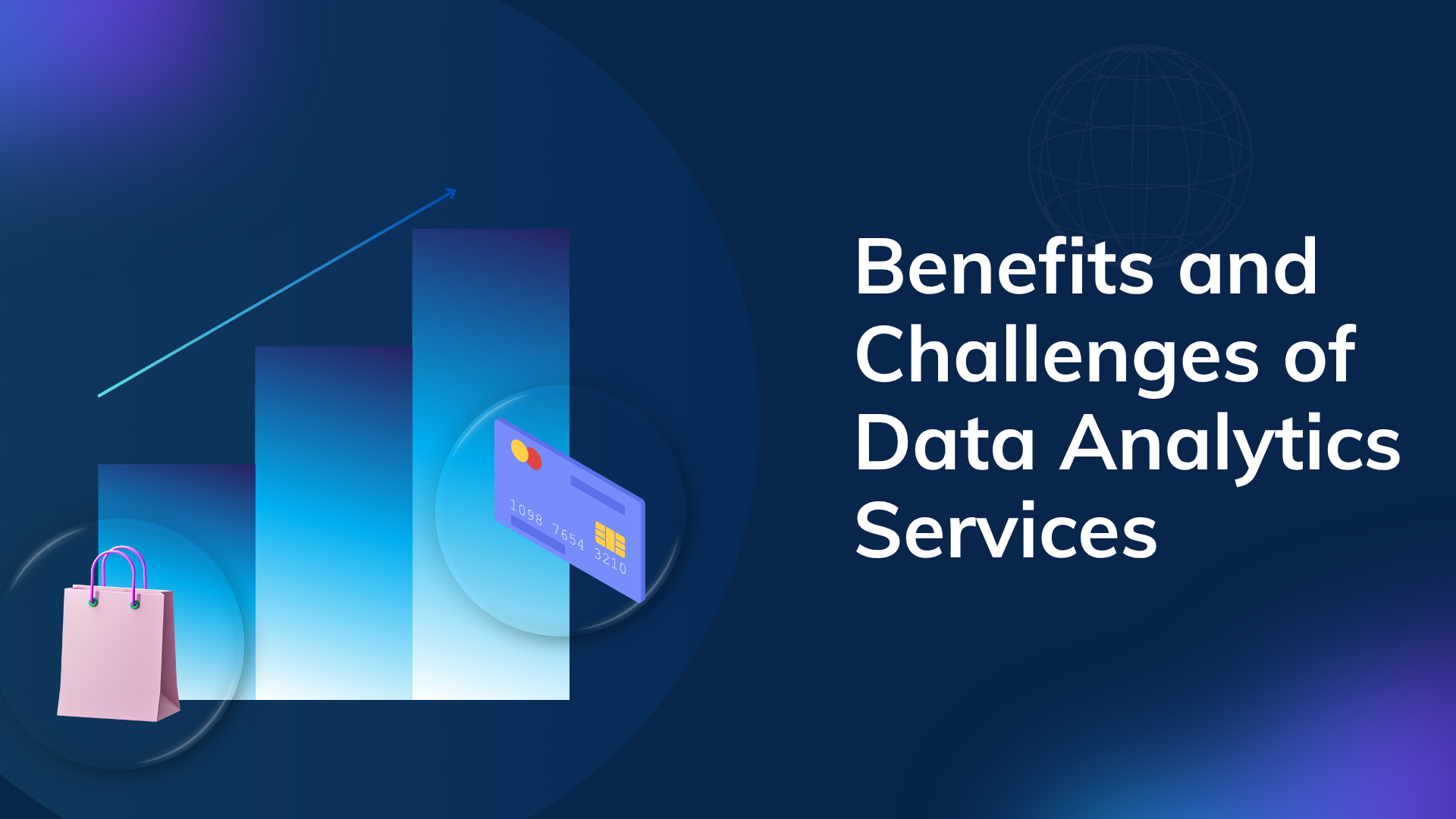Table of Contents:
- 1. Data analytics services
- 2. Business Analytics Solutions
- 3. advanced data insights
- 4. Big Data Consulting
- 5. Predictive analytics services
In a time of digital transformation, data analytics services have become a strategic base for essential business decisions. These services gather functions in collecting data, cleansing it, processing it, visualizing it, and finally interpreting it to analyze raw data for meaningful stakeholder insights. Whether it is through dashboards, predictive models, or machine learning algorithms, data analytics is the voice of organizations trying to make sense of complex information landscapes.
Therefore, controlling information has become crucial for businesses that generate and store huge amounts of data-everything from customer interactions to operational metrics. Data analytics equips companies to enhance operating efficiencies, stay ahead of competition, offer personalized customer experiences, and identify emerging opportunities and risks.
This blog analyzes the pros and cons of deploying data analytics services in a cyber business environment today. You will learn how these services create value for industries, the common pitfalls enterprises encounter during adoption, and the practical ways to resolve them.
Benefits of Data Analytics Services :
In the present age of information, using analytics is no longer merely a competitive advantage but has become a business necessity. Business analytics solutions help organizations convert raw data into valuable insights. Some of the benefits that businesses stand to gain from the use of data analytics services include:
1. Customer Experience Enhancement :
Understanding customer behavior helps to personalize experiences, which in turn helps in building loyalty and engagement. By analyzing data, companies can segment customers based on preferences, buying history, and interaction channels. These segments can be targeted for marketing, dynamic pricing, or specific service offerings.
Example: :
Netflix and Amazon are among the first companies to absorb user data in curating a personalized experience. Based on viewing history, search habits, user ratings, etc., Netflix recommends shows that fit individual preferences. Similarly, Amazon boosts conversion rates and satisfaction by recommending products based on prior purchases and browsing history.
2. Increased Operational Efficiency :
Once organizations find inefficiencies, bottlenecks, and cost-saving measures, data analytics can then be employed to streamline internal procedures. Operations effectiveness can be improved by analyzing workflow performance, resource allocation, and production timelines.
Example: :
A global manufacturing company took advantage of data analytics to optimize its supply chain. By combining data from suppliers, warehouses, and transportation systems, it was able to keep track of delays and inefficiencies. In particular, real-time tracking and predictive maintenance alerts minimized downtime and improved delivery times by 20%.
3. Competitive Advantage :
Organizations that reap the benefits from data analysis stay ahead of their competitors by anticipating market trends, consumer needs, and risks. Adhering to data-driven insight, companies may now proactively formulate their strategy for a competitive advantage.
Example: :
Companies track industry trends and consumer feedback through social listening and sentiment analysis. With advanced data insights, analytics functions similarly for fashion brands, enabling them to infer trending styles. Hence, they hurriedly move on with their product lines, one step ahead of the rivals that apply conventional forecasting techniques.
4. Revenue Growth Opportunities :
Data analytics opens a new avenue for revenue growth by analyzing customer behavior patterns and market dynamics. Firms can identify opportunities for cross-selling and upselling, and new product development and entry into untapped markets.
Example: :
By analyzing e-commerce browsing data and purchase behavior, it was discovered which product combos are frequently bought. On this basis, bundles were created, and offers directed at those bundles were set up. Thus increasing average order value and customer lifetime value.
Analytics also leads to data-driven product development through analyzing feature requests, usage patterns, and user feedback so that products can be launched that solve customer problems directly.
5. Risk Management and Fraud Detection :
With advanced analytics, businesses detect anomalies, assess risk, and react to threats in a proactive manner. Predictive models identify cases of fraud or non-compliance in fields such as finance, health, and insurance.
Example: :
Financial companies use machine learning systems trained on past transaction data to detect suspicious activity. Real-time detection and flagging of anomalies, such as high-value transactions carried out in a hurry or bizarre behaviors from a location, prevent fraud and build trust among clients.
6. Better Decision-Making :
Arguably, the best benefit of data analytics is faster, more accurate, and better decision-making. With insights coming in real-time, organizations can respond to changes in the market, customer demands, or internal inefficiencies rapidly. It would be impossible to examine a huge dataset and determine certain trends and patterns without the aid of analytics tools.
Example: :
A major retailer used predictive analytics services to improve its inventory management. Past sales trends were analyzed alongside weather patterns and regional demands so that the retailer could forecast better demand for products. This also greatly decreased stockouts and minimized overstock situations, contributed to extremely high customer satisfaction and profit margins.
Challenges of Data Analytics Services
While the benefits of data analytics services are truly transformative, organizations usually tend to face major hurdles in the implementation and use of these services. These issues range from technical constraints to cultural resistance and are supposed to be treated with strategic thinking to derive maximum value from investments in analytics.
1. Privacy and Security Issues
As businesses collect and store more sensitive data, concerns over privacy and security have increased. Organizations should comply with stringent data protection regulations such as the GDPR in Europe or the HIPAA in the U.S. Heavy fines and damage to reputation are just examples of penalties that an organization can face when it does not comply.
Likewise, there is an increasing risk of data breaches, cyberattacks, and misuse of personal information. Poor access control, lack of encryption, or outdated security practices can all create vulnerabilities within analytics systems. It is important to ensure the secure handling of data, whether at rest or in transit, to maintain customer trust and regulatory compliance.
2. Data Quality and Integration Issues
Uneven data quality is a well-recognized obstruction to quality analytics. Organizations often find themselves in situations that present inconsistent, incomplete, or duplicative data stored in different departments or legacy systems. Thus, it affects the sanctity of the analysis and paves the way for wrong decisions.
Another major challenge is data integration. Analytics platforms should be equipped to combine information originating from different sources, coming from databases. Unstructured information sources might be emails, documents, or social media sites.
Integrating different formats into a single view can be challenging and requires a lot of resources. Often, this process needs custom-built pipelines or various middleware solutions.
3. Supportively High Implementation Costs
It can be costly to develop and maintain any meaningful data analytics engine, especially for smaller and medium-sized enterprises. Examples of costs incurred are:
- Acquiring or licensing of analytics tools or platforms.
- Cloud storage and computing resources.
- Data integration solutions.
- Hiring a set of specialized professionals to look after and analyze the data.
However, most businesses may also be concerned with return on investment (ROI). If one does not 'clearly state objectives' and 'have measurable outcomes' to look for, it will be money spent on a costly experiment, rather than paying for business impact.
Therefore, to keep analytics effective and affordable, work with a team to create a clear process that focuses on delivering real value.
4. Lack of Skilled Talent
The demand for talented data professionals has skyrocketed in recent years, creating a global shortage of data scientists, analysts, and engineers. Their work, after all, involves data modeling, machine learning, statistical analysis, and application of such tools as Python, R, and SQL—skills that are barely found around.
Hence, the organizations are left to choose between upskilling existing talent or taking the incompetent market for the highest bidder. Both approaches have their trade-offs: upskilling requires time and internal commitment while hiring externally could be costly and a gamble on the cultural fit or competencies.
5. Resistance to Change
There's a certain resistance to change that still acts as an impediment despite the promise of data-driven transformation. Individuals who have been used to the "age-old," traditionally established way of making decisions trivially dismiss analytics or perceive it as a threat to automation and algorithm-driven insights.
To alleviate resistance:
- Executive buy-in and leadership support to champion data initiatives
- Training and education to instill confidence in analytics tools
- Clear articulation of how data complements rather than substitutes human decision-making
Developing a culture around data will be critical in ensuring the positive adoption and maintenance of this change.
Complexity of Choosing the Right Tools and Technologies
The existing marketplace offers numerous analytics tools, platforms, and solutions, all differing from one another in features, integrations, and pricing models. A non-technical business may find it hard to select tools.
Choosing platforms that are:
- scalable for future growth;
- easy for non-technical people to use; and
- compatible with existing IT infrastructure;
Makes a challenge. An improper tool choice can mean systems that do not communicate with each other, low user acceptance levels, and greater complexity at the operational level. Thus, it is prudent to carry out thorough evaluations, run pilot tests, and compare vendors before making long-term commitments.
Strategies to Maximize Benefits and Overcome Challenges
To explore all the capabilities of data analytics and increase the odds of circumventing obstacles, organizations must be proactive and strategic about it. Five key strategies put forth below can, therefore, help businesses unlock more value from their data while guarding against risks and inefficiencies.
a. Start with a Clear Data Strategy
The primary step before digging into analytics projects must be to establish clear business goals and tie analytics initiatives to specific business needs. Whether boosting customer retention, streamlining supply-chain operations, or forecasting sales- firms need these targeted strategies so that the efforts could be meaningful and measurable. Engaging business cases will get quick wins and generate adequate momentum to pursue further investments.
b. Invest in Scalable Tools and Infrastructure
Having scalability in the cloud-based platforms means being flexible and entering into a real-time user operation; they are also cost-efficient. Solutions offered scale with data volumes and growing user needs. Also, from a technology standpoint, modular and API-friendly tools ensure easy integrations with existing systems and smoother upgrades in the future. Such modularity is necessary for staying agile in an ever-changing tech landscape.
c. Data Governance and Compliance
Strong data governance frameworks are set up for this purpose, namely to keep data accurate and truthful and keep it safe. Organizations must put into action policies governing the very access to the data, sharing of information, retention of data, and permissions on the basis of roles. Regular compliance audits and continual upgradation of these policies to conform to ever-evolving regulations, such as GDPR or HIPAA, lessen legal risks and increase trust among all stakeholders.
d. Upskill Teams and Foster a Data-Driven Culture
Internal training, certification, and workshops are other investment priorities through which the team should be made capable of interpreting and acting on data insights with confidence. Management, on its part, should actively foster a data-driven culture in which employees at any level are encouraged to make decisions based on analytics instead of pure intuition. The cultural change itself is primary and crucial to adoption at scale and thereafter becoming successful.
e. Analytics with Trusted Partners
If there is a lack in the internal team, there is always an option to work with an analytics service provider to fulfill those gaps and help expedite the implementation process. Avoid putting your faith in partners who do not have a strong reputation from the standpoint of security, scalability, and customer care.
Conclusion
Data analytics services have become necessary for organizations seeking to innovate, gain efficiencies in their operations, and remain competitive. Becoming a data-driven business can be challenging due to issues like poor data quality, security risks, and a lack of skilled workers. However, you can overcome these challenges by creating a clear strategy and taking the right technical and cultural steps.
Through granting scalable infrastructures, enforcing practical governance, and fostering relationships with trustworthy partners, businesses can wholeheartedly work to extract the true value of data. Analytics is more than simply a tech trend: it is one of the core components for long-term evolution and infrastructural decision-making.
BestPeers, a renowned IT company, offers data analytics services to businesses that opt to organize and streamline their data. From big data solutions to data analytics consulting, our professionals will help you with overall data analytics services. Schedule an appointment with us today!




